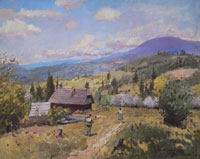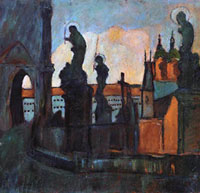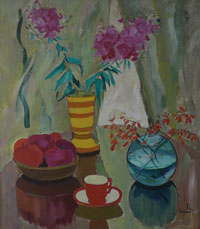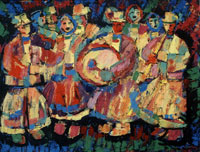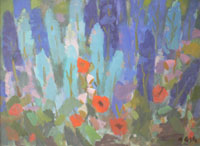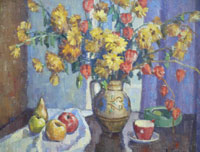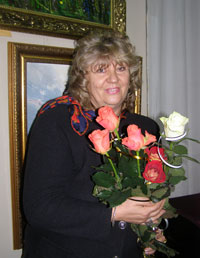 |
To illustrate the article we used the photographs of the paintings of Transcarpathian artists from Y. Bokshay Transcarpathian Art Museum. We are thankful for the kind and valuable assistance.
The term ”Transcarpathian school of painting” has been firmly fixed in the lexical arsenal of modern critics and art historians. The collectors and general public constantly take a proof interest in this artistic phenomenon. Popularity and success are always accompanied by the growing rating of leading Transcarpathian artists and their works. Peculiar aura of European manner and high professionalism designates this regional school always and everywhere. Transcarpathian school of painting displays engrossing prevalence of Personality in complicated art process. At the same time due to the joint efforts of the coryphaeus Transcarpathian school of painting shows the absolutization of spiritual origin.
Worked over the centuries historical and cultural mass of people’s art in all of its aspects turned out to be the energetic and esthetic potential that has became the turning point for all the Transcarpathian art. People’s mentality meant respectful attitude to the land of their ancestors. Orderly system of beliefs cultivated mentality. Ancient Slavic language as the energetic heart and symbol of ethnos was preserved in this land in purity and sanctity till the 20th century. Full of archaisms phonetic system of language bore melodious imagery of conceptual mode. Contemplative philosophy was peculiar to Transcarpathians. It helped to cultivate positive attitude to life.
Transcarpathian school of painting was exalted to the pedestal of honour in the period of ”Soviet epoch”. New power that came from the Carpathians in 1945 sent ”cultural forces” to help. Artists, painters, writers, journalists that came to Transcarpathia were astonished: the art they saw here was highly professional, talented, original and not regulated by the existing ideology. This was not expected…
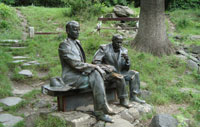 For many ages Transcarpathia was a part of Austro-Hungarian empire. The coexistence of different nationalities with their peculiar cultural traditions and the preservation of the authenticity of national cultures enriched the cohabitation of the people in the region. Relatively quiet course of living in the environs of Austro-Hungarian empire favoured the preservation of foundations and principles of ”patriarchal” existence of the people of the land. In the quiet the potential was accumulated. The group of outstanding figures didn’t emerge all of a sudden! Many artists are connected with Transcarpathia genetically and creatively, directly or indirectly: the genius of Hungarian realistic art Mihaly Munkacsi, the classic of Russian art Ihor Hrabar, and also such personalities as Simon Hollosi, Imre Revesz, Theodor Musson, Hnat Roshkovych.
For many ages Transcarpathia was a part of Austro-Hungarian empire. The coexistence of different nationalities with their peculiar cultural traditions and the preservation of the authenticity of national cultures enriched the cohabitation of the people in the region. Relatively quiet course of living in the environs of Austro-Hungarian empire favoured the preservation of foundations and principles of ”patriarchal” existence of the people of the land. In the quiet the potential was accumulated. The group of outstanding figures didn’t emerge all of a sudden! Many artists are connected with Transcarpathia genetically and creatively, directly or indirectly: the genius of Hungarian realistic art Mihaly Munkacsi, the classic of Russian art Ihor Hrabar, and also such personalities as Simon Hollosi, Imre Revesz, Theodor Musson, Hnat Roshkovych.
According to the results and secret agreements in Saint-Germain and Trianon after the First World War Transcarpathia became a part of Czechoslovakia as an autonomy and it lasted till 1939. This period of twenty years appeared to be very fruitful for cultural and educational process in the land. It was then that the epoch of the so called ”national revival of the land” – national renaissance – began. The Transcarpathian school of painting was also formed in that time.
It was usual for Transcarpathian artists to get the European artistic academic education in Budapest, Vienna and Prague and some went even to Munich and Paris. Yosyp Bokshay, Adalber Erdeli, Adalbert Apati-Abkarovich, Hnat Roshkovych, Omelian Hrabovskiy, Laszlo Dvan-Sarpataki, Dyula Iyasz, Karoly Izai were the graduates of different years of the Budapest Academy of Arts, Dyula Virag graduated from Munich Academy of Arts, Jeno Morvai – from the Jerusalem Academy, Andriy Kotska – from St. Lukas Rome Academy, Fedir Manaylo and Ivan Harapko – from the Prague High School of Art and Industry. Dyula Virag and for some time Dyula Iyasz studied at Juliene Academy in Paris.
The organization and creation of great art school was impossible without the necessary background. And it was formed in Transcarpathia in the first half of the 20th century. The subjective factor was in the presence of talented personalities who will realize their art potential and raise the successors. These personalities were able to teach, to share their experience with the art youth and to inspire them. Such were Y. Bokshay and A. Erdeli, the founders and teachers of the Transcarpathian school of painting. They are unique Personalities who were born to fulfil their mission. To take the responsibility not only for the pupils and successors but for the land’s painting on the whole is not an easy thing, is it? How many difficult exams were ahead! Could the pupils and the teachers pass them with dignity? Could Yosyp Yosypovych Bokshay foresee the times of artistic ”spiritual fast” that will come into this world? Interdiction of the church initiated by the party in Transcarpathia and all over Ukraine ruined the lives taking from the artist the very sense of spiritual life – the sacred art of soul. Here we can call to memory the tragic reflection of anxiety and sorrow about the future of Europe and of the whole world of vainness in ”XX century” (1931) by Adalbert Erdeli. Who knew that it would be so personal?
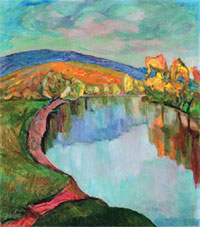 There is no doubt that the phenomenon of Transcarpathian school of painting is connected with the famous names of colleagues – companions, Y. Y. Bokshay (1891 – 1975) and A. M. Erdeli (1891 – 1955). After distress during the First World War and captivity in southern provinces of tsarist Russia Yosyp Bokshay, the young graduating student of Budapest Academy of Arts, comes back home in 1918. He starts working as a teacher of painting and provincial painter at Mukachevo Greek – Catholic eparchy. At that time A. Erdeli who graduates from the same academy in Budapest a year later tries himself at Munich School ’Aschbe’ and exhibits at ’Glasspalats’ in Munich. High level of teaching at school of Anton Aschbe, a Slovenian, in Munich played a significant role in the formation of artistic tastes of A. Erdeli who did not like the conservatism of the older generation of ”academicians”.
There is no doubt that the phenomenon of Transcarpathian school of painting is connected with the famous names of colleagues – companions, Y. Y. Bokshay (1891 – 1975) and A. M. Erdeli (1891 – 1955). After distress during the First World War and captivity in southern provinces of tsarist Russia Yosyp Bokshay, the young graduating student of Budapest Academy of Arts, comes back home in 1918. He starts working as a teacher of painting and provincial painter at Mukachevo Greek – Catholic eparchy. At that time A. Erdeli who graduates from the same academy in Budapest a year later tries himself at Munich School ’Aschbe’ and exhibits at ’Glasspalats’ in Munich. High level of teaching at school of Anton Aschbe, a Slovenian, in Munich played a significant role in the formation of artistic tastes of A. Erdeli who did not like the conservatism of the older generation of ”academicians”.
 Geographical heart of Europe where the seeds of talent were growing ripe for so long has born the brilliant fruit of love to art – Transcarpathian school of painting. This school that would bring glory to the native land was founded with the efforts of two great men. The duet of Bokshay and Erdeli, brilliant by education and world outlook principles, appears to create the so called ”Private public school of painting” in 1927 and to raise the professional art in Transcarpathia to high level. The simple fact of private studio – school foundation in 1927 in Uzhhorod has played a significant role in the history of the land. Professionals know that to become an artist, a master, one must know the subject. The basis of Transcarpathian school of painting has always been honour, adherence to principles, democratism, free access to education. An Artist should make high demands of himself and know the world art.
Geographical heart of Europe where the seeds of talent were growing ripe for so long has born the brilliant fruit of love to art – Transcarpathian school of painting. This school that would bring glory to the native land was founded with the efforts of two great men. The duet of Bokshay and Erdeli, brilliant by education and world outlook principles, appears to create the so called ”Private public school of painting” in 1927 and to raise the professional art in Transcarpathia to high level. The simple fact of private studio – school foundation in 1927 in Uzhhorod has played a significant role in the history of the land. Professionals know that to become an artist, a master, one must know the subject. The basis of Transcarpathian school of painting has always been honour, adherence to principles, democratism, free access to education. An Artist should make high demands of himself and know the world art.
 Art pluralism of styles and likings in ”Private school” was based on mastering the systemic academic knowledge in drawing, composition and perspective. During the considerable period of time the works of Transcarpathians were united by the bent for decorativeness, the principle of reality of art and the complicated paradigm of relationships with the folk art of Carpathians. Active practices of plain-airs and also the marvelous nature of Carpathians that inspired artists for the creative work, were those instruments that served the general getting up of the artistic process. Traditions of artistic schools of Nogybanya, Kecskemet, Tyachiv, Munich and Paris were creatively grasped and taken into action. European openness, frankness in the relations with colleagues and sincerity were the characteristic features of the Transcarpathian school of pictorial art.
Art pluralism of styles and likings in ”Private school” was based on mastering the systemic academic knowledge in drawing, composition and perspective. During the considerable period of time the works of Transcarpathians were united by the bent for decorativeness, the principle of reality of art and the complicated paradigm of relationships with the folk art of Carpathians. Active practices of plain-airs and also the marvelous nature of Carpathians that inspired artists for the creative work, were those instruments that served the general getting up of the artistic process. Traditions of artistic schools of Nogybanya, Kecskemet, Tyachiv, Munich and Paris were creatively grasped and taken into action. European openness, frankness in the relations with colleagues and sincerity were the characteristic features of the Transcarpathian school of pictorial art.
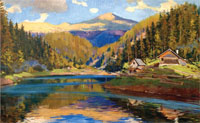 Humanism, often idealism and even romanticism marked by the artistic characters and folk-lore were crystallized as an important feature of a regional school on the background of the tragic, cruel events of the beginning of the 20th century. The dream of the artistic life in Transcarpathia was realized in the form of ”Carpathian Barbizon”. Each of the school founders brought in something new. Great selfless work of Y. Bokshay who conducted lessons on the main disciplines methodically and with high responsibility had a great effect. Exhibitions, expeditions, trips, plein airs, active civil work favoured good training of specialists. Adalbert Erdeli was bringing artistic Paris closer to the talented Transcarpathian boys not only by illustrating modern tendencies in art at practical lessons but also by involving students into active art process.
Humanism, often idealism and even romanticism marked by the artistic characters and folk-lore were crystallized as an important feature of a regional school on the background of the tragic, cruel events of the beginning of the 20th century. The dream of the artistic life in Transcarpathia was realized in the form of ”Carpathian Barbizon”. Each of the school founders brought in something new. Great selfless work of Y. Bokshay who conducted lessons on the main disciplines methodically and with high responsibility had a great effect. Exhibitions, expeditions, trips, plein airs, active civil work favoured good training of specialists. Adalbert Erdeli was bringing artistic Paris closer to the talented Transcarpathian boys not only by illustrating modern tendencies in art at practical lessons but also by involving students into active art process.
 Y. Bokshay and A. Erdeli were like fire and air in character but they were fraters in their hearts. Only Love was higher than this – Love to God, to people and to art. Could Y. Bokshay and A. Erdeli realize themselves separately? Yes, they could. But they couldn’t imagine themselves without Transcarpathia. Adalbert Erdeli did not get lost in populous Paris. He was living and working here in 1929 – 1931. This journey to Paris was stimulating for a young artist. A large city has always attracted artists. Everyone wanted to wake up famous. Paris set the fashion. It lived on emotions and was generous only to the idols. Historical sources tell that fourty thousand of artists searched for the patrons, the public, the fame and the money in Paris in the 30s of the 20th century. A. Erdeli achieved success but he returned home. He couldn’t exist without Transcarpathia.
Y. Bokshay and A. Erdeli were like fire and air in character but they were fraters in their hearts. Only Love was higher than this – Love to God, to people and to art. Could Y. Bokshay and A. Erdeli realize themselves separately? Yes, they could. But they couldn’t imagine themselves without Transcarpathia. Adalbert Erdeli did not get lost in populous Paris. He was living and working here in 1929 – 1931. This journey to Paris was stimulating for a young artist. A large city has always attracted artists. Everyone wanted to wake up famous. Paris set the fashion. It lived on emotions and was generous only to the idols. Historical sources tell that fourty thousand of artists searched for the patrons, the public, the fame and the money in Paris in the 30s of the 20th century. A. Erdeli achieved success but he returned home. He couldn’t exist without Transcarpathia.
Y. Bokshay has also perfected himself on the best pieces of sacred art in the museums of Vatykan, Rome, Munich, Dalmatsii. But he never left Transcarpathia for a long time because he was very busy working as a teacher and provincial artist.
Transcarpathian artists perceived the spiritual principles of the coryphaeus of fine art – Y. Bokshay and A. Erdeli. Highly educated A. Erdeli, Y. Bokshay, O. Hrabovskiy and later on A. Kotska, E. Kontratovych, A. Boretskiy, Z. Sholtes, A. Dobosh, the first graduating students of Private school of painting, who were concerned about the destiny of their land considered it to be the matter of honour to serve people with their art. Bokshay and Erdeli, ideological leaders, tutors and teachers, were the life of artistic and professional groups. In 1931 the Association of Pidkarpatska Rus fine art workers was founded and in a year it had already united 38 artists with A. Erdeli at the head of it since the very first days. In the Soviet period, on 16 August, 1946, Transcarpathian branch of the Union of Artists of Ukraine was opened under the heading of A. Erdeli and it gathered such artists as Yosyp Bokshay, Omelyan Hrabovskiy, Fedir Manaylo, Andriy Kotska, Zoltan Sholtes, Adalbert Boretskiy, Mykola Rozenberg, Vasyl Svyda, Ivan Harapko, Ernest Kontratovych, Yevhen Hryunvald, Andriy Dobosh.
Everyone who one way or another met the coryphaeus or learned from them speaks about it with dignity. Is it an indulgence for an artist? Of course, it is not. But it gives rise to talk about the school. It is not a secret that not everyone nowadays, especially the young, thinks it makes sense to single out the phenomenon of Transcarpathian school of painting. Of course, the standards and examples are changing. Dry ”exhausted” theory will not add life to something prepared in laboratory. Another question is for how long the leading figures in the history of Transcarpathian fine arts, Y. Bokshay and A. Erdeli, will have an influence on the artists. It will probably pass more than ten years for us to confess. Only those first courageous and lucky men who were side by side with them, the young and flaming, could breathe one air with them. Air atoms and molecules haven’t changed since then. But where are they, Adalbert Erdeli and Yosyp Bokshay?
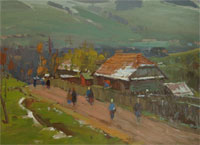 They are with us as well as their beautiful, eternal art. Refined thrilling lines in A. Erdeli paintings resemble the eternal secret of love. He discovered this eternity in people: in his girl friend, in his beloved, in his mother and in himself. His ideals were faith in love and good. But he reached them through heart ache of his expressive art, his crusade fate. A. Erdeli searched for symbolics in surrounding world in which the essence and the thing coincided.
They are with us as well as their beautiful, eternal art. Refined thrilling lines in A. Erdeli paintings resemble the eternal secret of love. He discovered this eternity in people: in his girl friend, in his beloved, in his mother and in himself. His ideals were faith in love and good. But he reached them through heart ache of his expressive art, his crusade fate. A. Erdeli searched for symbolics in surrounding world in which the essence and the thing coincided.
His art was not symbolic, it explained the symbolism of the world in a philosophic way in the language of still life and flowers paintings. He searched for rhythms in painting to brighten up the colours. He himself set all the rules in the field of action called the painting, taking as a model the art of Sezanne and Matisse. Adalbert Erdeli was impressed by the decorative coloured semantics of Vlamink and Deren’s paintings. Due to the peculiarities of the composition the inside energy of Erdeli’s paintings increased. The artist’s great interest was the genre of landscape painting in which he felt happy in his colourful dreams and feelings. Approaching the French standards he easily combined bright and vivid colours. However, a magnificent tornado of colours is sometimes noticed in Erdeli’s works. The artist’s favourite ”Paris green” – the paint of dim discoloured eaves of city architecture that marked the day on the Seine or Vltava. This green reminds us about the unfading youth of soul of talented artist from Transcarpathia, about his glory and pride – about Adalbert Erdeli.
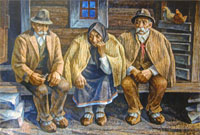 Searching for his own way in art A. Erdeli was able to take what he needed from the national cultures of Hungary, Germany, France and Ukraine to create his own style. The depth of Erdeli as a master is in colour, in his own interpretation of the dynamics of emotions, in complete absence of indifferent or ”dead” sketches. This was not present in his nature. The plastics of colour combinations made the essence of the paintings saturated with breathing and beating of the master’s heart. Personal exhibitions of the prominent artist were held in Munich (1923), Prague (1929) and in Uzhhorod (1954). A. Erdeli remained in public memory as a knight and a poet, an artist and an aristocrat, a great man of Ukrainian and world art.
Searching for his own way in art A. Erdeli was able to take what he needed from the national cultures of Hungary, Germany, France and Ukraine to create his own style. The depth of Erdeli as a master is in colour, in his own interpretation of the dynamics of emotions, in complete absence of indifferent or ”dead” sketches. This was not present in his nature. The plastics of colour combinations made the essence of the paintings saturated with breathing and beating of the master’s heart. Personal exhibitions of the prominent artist were held in Munich (1923), Prague (1929) and in Uzhhorod (1954). A. Erdeli remained in public memory as a knight and a poet, an artist and an aristocrat, a great man of Ukrainian and world art.
Yosyp Bokshay is a classic of realistic fine art, an outstanding master, a talented artist and a pedagogue. He is the creator of epic landscape painting, the master of composition, of great graphic technique and of highly individual portraits. He went down into the history of Ukrainian fine art as one of the most talented monumental painters of the 20th century.
 On the all-European scale the significance of the painter’s art heritage goes far beyond the Carpathian region. One can get acquainted with the easel painting and monumental works of Yosyp Bokshay not only in Ukraine but also in the neighbouring countries such as Hungary, Slovakia, Poland, Romania and Czech Republic. The leading idea and the main peculiarity of the artist’s highly spiritual works is the combination of earthly and heavenly in man. The gold of ”Bokshay” autumn is depicted in majestic Carpathian landscapes. The fundamental synthesis of the sacred with deeply national was up to the artist’s beliefs and his conception of the world.
On the all-European scale the significance of the painter’s art heritage goes far beyond the Carpathian region. One can get acquainted with the easel painting and monumental works of Yosyp Bokshay not only in Ukraine but also in the neighbouring countries such as Hungary, Slovakia, Poland, Romania and Czech Republic. The leading idea and the main peculiarity of the artist’s highly spiritual works is the combination of earthly and heavenly in man. The gold of ”Bokshay” autumn is depicted in majestic Carpathian landscapes. The fundamental synthesis of the sacred with deeply national was up to the artist’s beliefs and his conception of the world.
 Yosyp Bokshay loved his motherland with all his heart. He proclaimed the life asserting spirit of the light and the truth with his religious paintings. He has always spoke honestly with his colleagues. He protected himself from the evil with the prayers, his faith and natural kindness. A great number of the painter’s talented monumental and easel paintings glorified and generalized the poetic image of his native land famous for its steepy mountains and picturesque fields and, of course, for its people. There are many figures in Yosyp Bokshay canvases – they are either episodic ones or great portraits of clergy and ordinary highlanders. The prominent trait of character of Bokshay as a teacher was his desire to study always and everywhere. He said that it is not known yet who studies from whom and who teaches whom. Being an elderly man already he was always tolerant of the views of his younger colleagues. He believed in God. It was not a ritual, it was life. While being still in his youth and studying at honoured masters of Budapest Academy of Arts Yosyp Bokshay have chosen realism to become his favourite style in painting. In the course of time he realized the effect of reality rendering on the canvas by expressing it in fine art. So, the crystal shadows in ”Autumn” (1969) persuade us of the virtuosity of the concrete landscape drawing up through the prism of painting. Most of the Y. Bokshay lyrical works are made according to the genre peculiarities: light and shadow effects are taken into account, colours, chromatic stretchings and contrasts are considered. The skill of the realistic painter revealed in the subjectivity of his ”impressions” becomes apparent in the masterpiece of illusiveness seen by the spectator.
Yosyp Bokshay loved his motherland with all his heart. He proclaimed the life asserting spirit of the light and the truth with his religious paintings. He has always spoke honestly with his colleagues. He protected himself from the evil with the prayers, his faith and natural kindness. A great number of the painter’s talented monumental and easel paintings glorified and generalized the poetic image of his native land famous for its steepy mountains and picturesque fields and, of course, for its people. There are many figures in Yosyp Bokshay canvases – they are either episodic ones or great portraits of clergy and ordinary highlanders. The prominent trait of character of Bokshay as a teacher was his desire to study always and everywhere. He said that it is not known yet who studies from whom and who teaches whom. Being an elderly man already he was always tolerant of the views of his younger colleagues. He believed in God. It was not a ritual, it was life. While being still in his youth and studying at honoured masters of Budapest Academy of Arts Yosyp Bokshay have chosen realism to become his favourite style in painting. In the course of time he realized the effect of reality rendering on the canvas by expressing it in fine art. So, the crystal shadows in ”Autumn” (1969) persuade us of the virtuosity of the concrete landscape drawing up through the prism of painting. Most of the Y. Bokshay lyrical works are made according to the genre peculiarities: light and shadow effects are taken into account, colours, chromatic stretchings and contrasts are considered. The skill of the realistic painter revealed in the subjectivity of his ”impressions” becomes apparent in the masterpiece of illusiveness seen by the spectator.
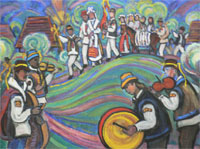 Yosyp Bokshay was wise in people’s way that is why he was clear and close to the people. He was honoured the highest titles and degrees: People’s Artist of USSR – in 1963, corresponding member of the Academy of Arts of USSt – in 1958. Artist’s personal exhibitions were held in Uzhhorod in 1962, 1963, 1971 and in Kyiv in 1978.
Yosyp Bokshay was wise in people’s way that is why he was clear and close to the people. He was honoured the highest titles and degrees: People’s Artist of USSR – in 1963, corresponding member of the Academy of Arts of USSt – in 1958. Artist’s personal exhibitions were held in Uzhhorod in 1962, 1963, 1971 and in Kyiv in 1978.
People’s artist of USSR Y. Bokshay and his colleague A. Erdeli are the legendary figures in Ukrainian fine art. A great number of people want to meet them and to see their paintings. Yosyp Bokshay and Adalbert Erdeli as well as their successors witnessed the vital truth of art with their original and highly professional works.
The beauty of Ukrainian and European fine art is local Transcarpathian school of painting founded by fellow – colleagues Y. Bokshay and A. Erdeli. Transcarpathian painters have taken the leading positions in Ukrainian fine art very quickly. Strong, talented and original creators advanced to art by Yosyp Bokshay and Adalbert Erdeli, their great contemporaries, they announced about the high level of regional art due to the merits of Transcarpathian school of painting.
Raised on the traditions of people’s life-asserting art, due to the professional academic training, the best achievements of world culture and plein airs experience Transcarpathian painters proved their vitality and strong working potential. The circle of Bokshay and Erdeli pupils is formed of bright, original, artistic individualities. These are lyrical A. Kotska, monumental and polyphonic A. Boretskiy, pictorial A. Dobosh, contemplative and melodic Z. Sholtes, philosophic E. Kontratovych, epic A. Kashshay, picturesque I. Shutev, sentimental V. Habda, ethnic and folklore Y. Herts, considerate V. Mykyta and others. The range of personalities proves the powerful stream of life giving source of Transcarpathian fine art and, in the first place, the charism of Yosyp Bokshay and Adalbert Erdeli, the founders of Transcarpathian school of painting. They were its creators, motive force of this great phenomenon that in fact has become the catalyzer of national revival in Transcarpathia in the 30s of the 20th century. They have raised the artist and the spectator of this place. With their efforts an impulse was given to the emergence of many names, figures, styles and manners. They had enough ambitions to bring to life their ideas in art not only in the 20th century but in all the centuries to follow.







